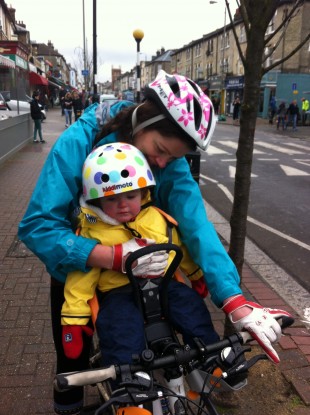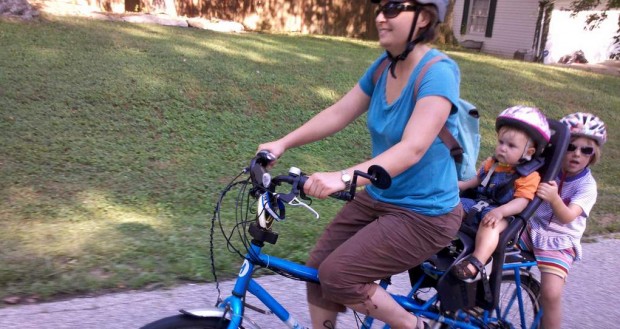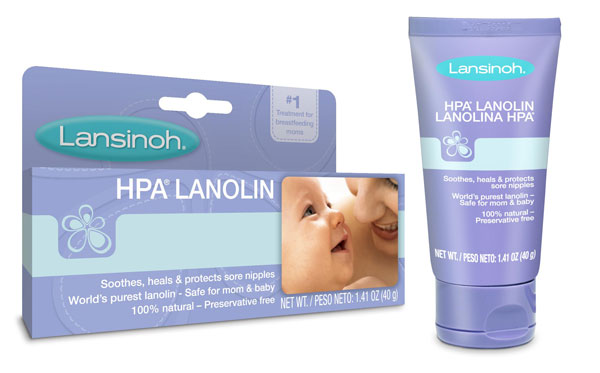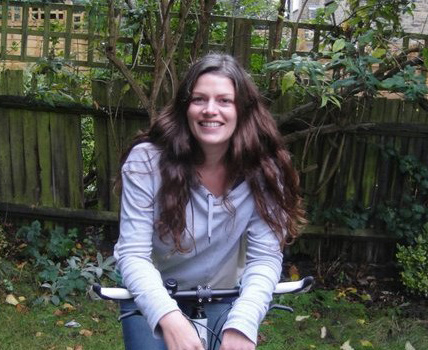
Regardless of whether or not you cycled during your pregnancy, at some point after that little bundle of joy arrives you may start thinking about when you can hop on your bike again.
Cathy Bussey, author of ‘The Girl’s Guide to Life on Two Wheels‘ and mum of one, with another on the way – explores what you should expect from your body.
You might be desperate to regain a bit of ‘the old you’ and start training, or hoping cycling will help you lose the baby weight.
If you had a difficult birth, or it’s your first baby, it’s likely you’ll be more wary than eager to get back in the saddle. But if everything went smoothly, or this isn’t your first child, you may be surprised how quickly your body bounces back.
Cycling and parenting forums are packed full of queries from new mums raring to get back on their bikes and wondering if they have to wait for the all-clear from the doctors.
If you recover from childbirth quickly it can be easy to forget that your body has been through an enormous ordeal. While you might feel like your old self, your body will still be healing long after you think it’s back to normal.
Getting back in the saddle
It’s unwise to carry out any form of exercise more strenuous than looking after your baby, or children, for six weeks after childbirth. Your uterus will still be enlarged and healing, and your cervix remains open.
Be patient and stick to working that pelvic floor. You may also want to try some gentle stretches and some hospitals will provide a series of suggested exercises to gently help your body post-birth. Ask your doctor or midwife for advice.
If, after six weeks, your doctor has given you the all-clear, then you can hit the bike, but take it steadily and listen to your body.
If you had a c-section or stitches you may take longer to heal and be advised to avoid exercise for three months or longer. Again, don’t be tempted to start too soon. Childbirth is a major event for your body. Just because it’s ‘natural’ doesn’t mean it can’t be extremely physically traumatic.
Once you do have the all-clear from the doctor, if you’re still wary about your ‘area’ try swimming or another form of gentle exercise, invest in super-duper padded shorts or even consider a recumbent bike if you genuinely can’t face the thought of an upright saddle.
Your body is still healing
Build up your training gradually. If you notice any bleeding, or unusual pain or discomfort during or after training, stop immediately and consult your doctor.
It can take your body up to a year to fully return to its ‘old self’ after pregnancy and birth. Pregnancy hormones relax the muscles, meaning your ligaments are looser and more at risk of sprains and injuries. The effects last beyond childbirth so if you are supplementing your cycling with yoga or Pilates, be careful not to hyper-extend.

https://www.flickr.com/photos/
Additionally your abdominal muscles may have separated, a side-effect of pregnancy that affects about one third of women. If yours have, consult your doctor and focus on core exercises that will help bring the muscles back together. Avoid wrenching these muscles with vigorous sit-ups until they have come together again.
Breastfeeding and nutrition
If you are breastfeeding you need to be eating enough to keep your milk supply up, and if you are training, you may need more calories on top of this. If you are not breastfeeding, the demands of being a new mum are still strenuous and now is not the time to try out the fasting diet.
Eat sensibly, focusing on foods that will energise and sustain you, and avoid filling up on junk food for a quick fix. The occasional treat is fine, particularly if you are breastfeeding as this can burn up to 500 calories a day. But don’t overdo it.
It is an oft-touted line that if you breastfeed, the baby weight will melt off of its own accord. If you fall into this category, good for you! I myself am living proof that this is not true in all cases and in fact a stone of my excess ‘padding’ clung stubbornly, despite a half-marathon, until I stopped breastfeeding after nine months.
If your baby weight doesn’t simply dissolve the minute Junior latches on, you’re not ‘doing it wrong’ and you absolutely don’t need to go on a crash diet.
Breastfeeding can make you ravenous – it did me – and it’s more important to ensure you and your baby are getting the nutrition you both need, than it is to be at racing weight two months after childbirth.
Breastfeeding and exercise
If you breastfeed your breasts are likely to remain more impressively sized than usual for the duration, so invest in a decent, well-fitting sports bra for cycling and other activities.
Breastfeeding affects all women differently. For the first six months I lived in breast pads as I was leakier than a dodgy kitchen tap. You may find your nipples are sore and sensitive and that exercise chafes them, in which case a soothing cream like Lansinoh may help.

You may have heard or read that excess lactic acid produced by exercise can make your milk taste sour. There is absolutely no evidence to support this whatsoever. It’s fine to exercise while breastfeeding, even at intense levels, as long as your body is ready and capable. What is vital however is to stay hydrated – before, during and after workouts – and to ensure you are eating enough to keep your energy levels up.






